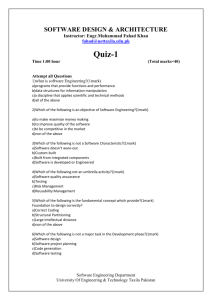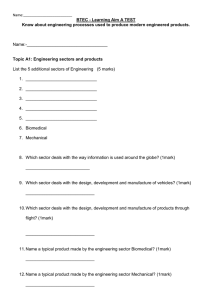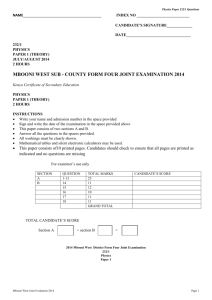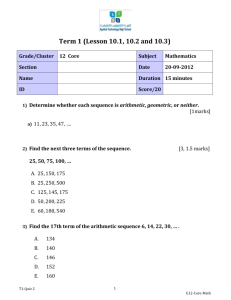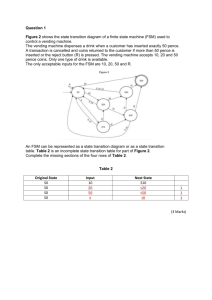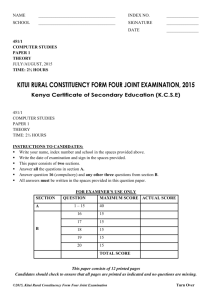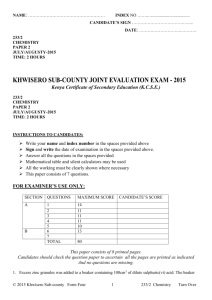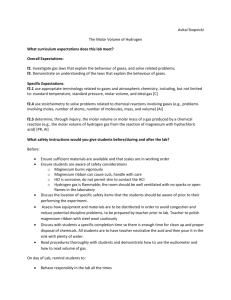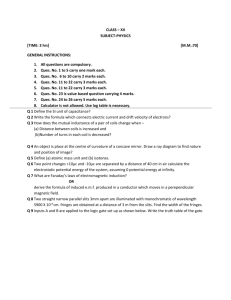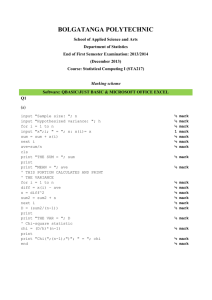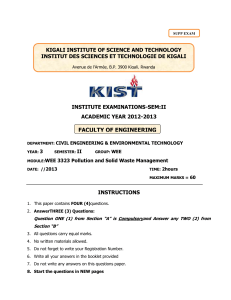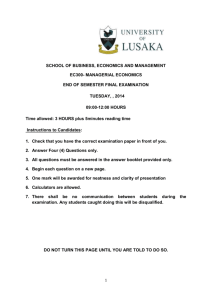BIO P1 - M.S
advertisement
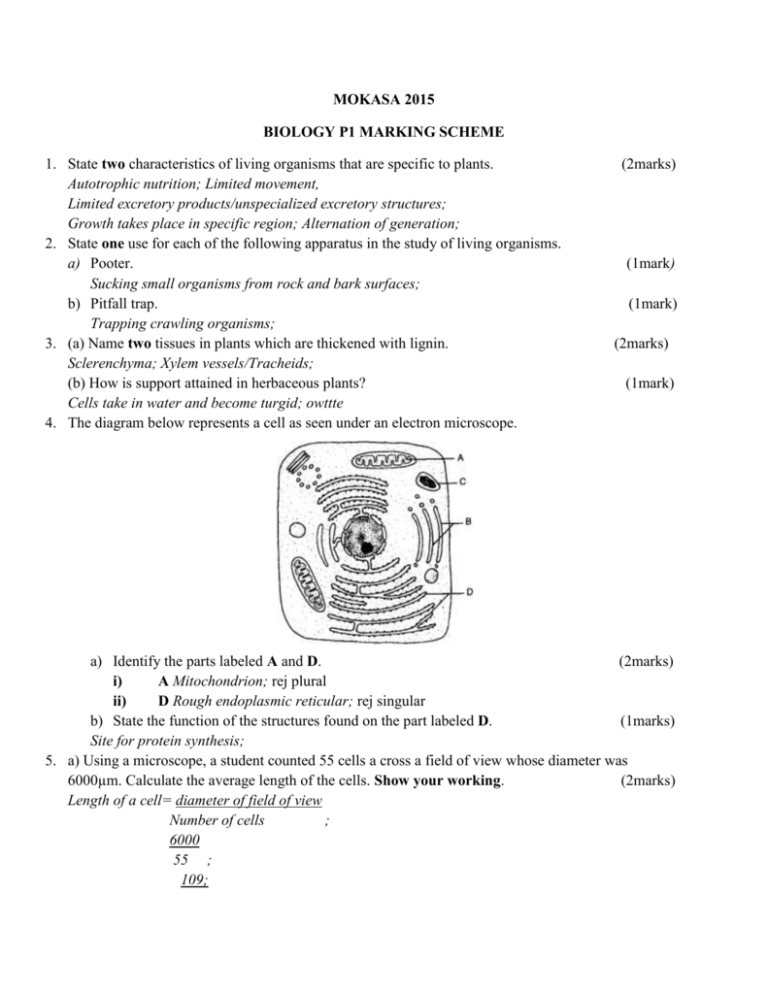
MOKASA 2015 BIOLOGY P1 MARKING SCHEME 1. State two characteristics of living organisms that are specific to plants. Autotrophic nutrition; Limited movement, Limited excretory products/unspecialized excretory structures; Growth takes place in specific region; Alternation of generation; 2. State one use for each of the following apparatus in the study of living organisms. a) Pooter. Sucking small organisms from rock and bark surfaces; b) Pitfall trap. Trapping crawling organisms; 3. (a) Name two tissues in plants which are thickened with lignin. Sclerenchyma; Xylem vessels/Tracheids; (b) How is support attained in herbaceous plants? Cells take in water and become turgid; owttte 4. The diagram below represents a cell as seen under an electron microscope. (2marks) (1mark) (1mark) (2marks) (1mark) a) Identify the parts labeled A and D. (2marks) i) A Mitochondrion; rej plural ii) D Rough endoplasmic reticular; rej singular b) State the function of the structures found on the part labeled D. (1marks) Site for protein synthesis; 5. a) Using a microscope, a student counted 55 cells a cross a field of view whose diameter was 6000µm. Calculate the average length of the cells. Show your working. (2marks) Length of a cell= diameter of field of view Number of cells ; 6000 55 ; 109; b) State the function of the following parts of a light microscope i) Objective lens. (1mark) Magnification (of images); owtte ii) Diaphragm. (1mark) Regulation of a mount of light (falling on the object/specimen on microscope); 6. (a) Name the fluid that is produced by sebaceous glands. (1mark) Sebum; (b) What is the role of sweat on the human skin? (2marks) Kills micro-organisms; cools the body; getting rid of wastes/excretion; 7. What is the importance of the following in an ecosystem? (2marks) a) Decomposers Recycling off nutrients; owtte b) Predation Regulation of numbers/population; owtte 8. (a) State two functions of bile juice in the digestion of food. (2marks) Emulsification of fats/breaking into small droplets; increase surface area for digestion; neutralizing acidity of chime/provide alkaline medium (for enzyme action); (b) How does substrate concentration affect the rate of enzyme action? (1mark) 9. Name the features that increase the surface area of small intestines. (2marks) Presence of villi; Long length; 10. Describe what happens during the light stage of photosynthesis. (3marks) Light (energy) is observed by chlorophyll; the light splits/photolysis water molecule; to form hydrogen ions/atoms and oxygen gas; (Light is converted to) and also forms Adenosine triphosphate (ATP); 11. (a) Define the following terms. (2marks) i. Population The number of organisms of a species occupying a given habitat; ii. Community (populations) of different species of plant and animals in a given area and are interacting with each other; (b) Name a method that could be used to estimate the population size of the following organisms. i. Fish in a pond. (1mark) Capture – recapture (method); ii. Black jack in a garden. (1mark) Line transect/ Belt transect/ Quadrat; 12. (a) What is meant by the term allele? (1mark) (A gene is an) Alternative form of a gene; (b) Explain how the following occur during gene mutation. (i) Deletion. (1mark) Some bases/nucleotides of a gene are removed; (ii) Inversion. (1mark) The order of some bases/nucleotides is reversed; (c) What is a test-cross? (1mark) A cross made between a homozygous recessive individual/parent and a parent/individual of unknown genotype (to determine whether the unknown genotype is homozygous or heterozygous for dominant gene); 13. Explain what happens when there is oxygen debt in human muscles. (2marks) Muscles are subjected to respire anaerobically; resulting in accumulation of lactic acid in the tissues; causing fatigue/and muscle cramps; 14. The diagram below shows a transverse section of a plant organ. a) Name the class to which the plant organ was obtained. (1mark) Monocotyledonae; b) Give a reason for your answer in (a) above. (1mark) Vascular bundles scattered/not arranged in a ring; absence of pith; absence of vascular cambium; 15. Giving a reason in each case, name the class to which each of the following organisms belong: (4marks) Bean plant Dicotyledonae; Reason Leaves are net veined; have leave petiole/tap root system/cross-section of vascular bundles are arranged (around pith) star shaped xylem in roots/phloem in between arms of xylem/ floral parts are in 4s or 5s or multiples of 4a/5s/ two cotyledons; Any one. Bat Mammalian; Reason Presence of fur/hair/mammary glands/sweat glands/ presence of two pina/heterodont dentition/ear oscicles; Any one. 16. (a) Name the causative agents of the following diseases in humans. (2marks) Typhoid Salmonella typhi Amoebic dysentery Entamoeba hystolytica; (b) Name the disease in humans caused by Plasmodium falciparum. (1mark) Malaria; 17. State three differences between Chilopoda and Diplopoda. (3marks) Chilopoda Diplopoda A pair of (walking) legs per segment; two pairs of walking legs per segment; Body flattened dorsoventrally; Body cylindrical Body divided into head and trunk/two parts; Body divided into head, thorax, trunk / three parts; Has poisonous claws; lacks poisonous claws; Posterior genital aperture; posterior 18. What are the limitations of fossil records as evidence of organic evolution? (1mark) Several missing fossils records (missing links); these have occurred due to complete decomposition of whole organism/scavenged upon/lack of conditions for fossilization/discovery of few fossils; Distortion of parts of fossil during sedimentation which gives wrong impression of the structures; Distortion of fossils by geological activities e.g. earthquakes, faulting, uplifting and mass movement. 19. The diagram below represents a member of the kingdom Animalia. i) ii) Name the phylum to which the organism belongs. (1mark) Arthroppoda; Using observable features in the diagram, give three reasons for the answer in (i) above. (3marks) Segmented body; Jointed appendages; Presence of exoskeleton; 20. The diagram below shows a stage during fertilization in plants. micropyle a) Name the parts labeled Q and R. (2marks) Q Antipodal cell(s); R Polar nucleus/nuclei: b) State the function of the pollen tube. (1mark) Secretes enzymes that digest the stigma/style/ovary tissue; Offer passage for male nuclei to ovum and polar nucleus/embryo sac; c) On the diagram, label the micropyle. (1mark) 21. The diagram below represents a human foetus in a uterus. a) Name the types of blood vessels found in the structure labeled Q. (2marks) Arteries; Veins; b) Name two features that enable the structure labeled P carry out its function. (2marks) Highly vascularised; has (villi) that provide a large surface area; presence of secretory cells (glandular) that produce progesterone; 22. Name the type of skeleton that makes up each of the following animals. (3marks) a) Cockroach Exoskeleton; b) Bird Endoskeleton; c) Earthworm Hydrostatic; 23. (a) Highlight two survival values of tropic response. (2marks) Phototropisms expose the leaves in position to maximize light absorption thereby enhancing photosynthesis Hydrotropism enables the roots of the plant to seek water important in biochemical processes in plants. Haptotropism enables the plants obtain mechanical support, especially in those plants lacking woody stems. Geotropism enables plants roots to grow deep into the soil thus offering firm anchorage; Chemotropism enables the pollen tubes too grow towards the embryo sac thereby facilitating fertilization; ( first two) (b) What is a klinostat? (1mark) A device/instrument which slowly rotates a plant to nullify the effect of unidirectional stimulus; (c) Name the type of movement that occurs within a plant cell. (1mark) Cytoplasmic streaming; 24. Name:a) The pressure sensitive swellings at the base of some leaves and petals which through loss or gain of turgidity bring about nastic movements. (1mark) Pulvini; b) The structure in cockroach used for detecting stimuli. (1mark) Cerci/circus; c) The growth movement of part of plants in response to a unidirectional external stimulus. (1mark) Tropic (response); 25. The diagram below shows a transverse section of a leaf. Study it carefully then answer the questions that follow. a) Name the habitat of the plant from which the leaf was obtained. (1mark) Aquatic/fresh water; b) Give two reasons for your answer in (a) above. (2marks) Large air spaces/aerenchyma tissues; Sclereids; Stomata on upper epidermis/surface//absence of stomata on lower epidermis; Absence of cuticle; Poorly developed vascular bundles; 26. (a) Name the gaseous exchange surface in insects. (1mark) Tracheoles; (b) How is the surface named in (a) above suited to its function. (2marks) Moist for gases to dissolve in solution; Branched/many/numerous to increase surface area; thin for fast diffusion; 27. Most carbon (IV) oxide is transported from tissues to the lungs within the red blood cells and not in the blood plasma. Give two advantages of this mode of transport. (2marks) PH of blood plasma is not altered/homeostasis is maintained; within the red blood cells, there is enzymes (carbonic anhydrase) which help in fast loading/combination and offloading/dissociation of carbon (IV) oxide.
